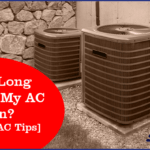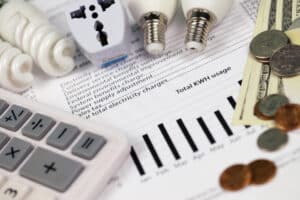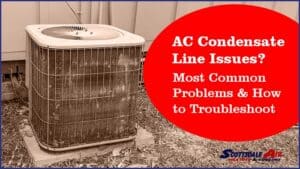Most people are so used to being able to control the temperature of their homes that they do not realize how much it contributes to their quality of life.
However, there are more than 118,000 heating and air conditioning contractor businesses around the United States.
That is just some indicator of how much demand there is from people to help them maintain their home heating and cooling systems.
Is your AC thermostat not working?
When this happens, some people think there is nothing to do except call the professionals.
The truth is that there are some problems that you might be able to resolve on your own.
Learning a little bit more about how to troubleshoot your thermostat can help you know when you can save money solving your own problem versus when you need to call the experts to manage a job that is too big for a layperson.
So how can you troubleshoot your thermostat?
Read on to learn all about the most important steps to take for a thermostat troubleshooting process!
Thermostat Troubleshooting Broken Sensors
Many people do not recognize how much their thermostat depends on functional sensors.
Sensors inform your thermostat of the temperature of your home.
Without the information they provide, your thermostat will not know whether to instruct your HVAC system to heat or cool your house.
If your thermostat is not working, one of the most common causes might be an issue with your sensors.
Your sensors might require special repairs, or they might need replacement completely.
Sensors are such an integral part of the thermostat system that any problem with them generally means you need to call HVAC professionals.
Although there are other problems you can probably fix on your own, this is not one of them.
Check Your Thermostat Location
Not every HVAC professional does quality work.
Sometimes, HVAC professionals install thermostats in poor locations.
Suppose that your thermostat has sensors placed right next to a window with poor insulation.
The sensors might constantly be reading a cooler temperature than the rest of your home is at.
They might then continuously instruct your HVAC system to heat up your home.
The exact opposite problem could happen if your thermostat sensors are placed too near a fireplace or oven.
The sensors will continuously read that the home temperature is warm.
They will then turn around and inform your HVAC system that it needs to cool down your house.
Check your thermostat location to see if it is near any unusually warm or cool parts of your home.
If it is, you may need to move it.
Clean Up Dirty Equipment
Sometimes, a thermostat is not working simply because it is not clean.
This is an unusually simple problem that you might be able to resolve yourself.
Open up your unit and inspect it for signs of a buildup of dust or lint.
If you find a significant amount of contamination in your unit, that is some indication that that contamination might be interfering with the proper functioning of the thermostat.
You want to be very careful when cleaning a thermostat. This is especially true if you see any wires in the vicinity you are cleaning.
Make sure to use soft cleaning tools.
You should also make sure not to get the area wet.
Take extra care not to pull or prod any wires you encounter.
Check Your AC Thermostat for Corrosion
Corrosion is an inevitable problem for electrical systems.
What starts as trivial corrosion can eventually grow in significance until your electrical components cannot function properly.
If you think that your thermostat system might have some trouble with corrosion, you can use an electronic contact cleaner.
If this solves your problem, then you should be careful about the possibility of corrosion in the future.
Consider the Possibility of Poor AC Thermostat Wiring
If a thermostat system is installed badly enough, people will usually fix it right away.
However, if it is installed just well enough to work for a year or so, you might end up with a working thermostat that suddenly stops working consistently.
You might even find that the thermostat only occasionally doesn’t work.
If your thermostat occasionally doesn’t power on at all, the problem might be loose wiring.
If you look inside your unit, you might be able to tell that some of the wires are not properly attached where they are supposed to be.
Although you may be able to handle some wiring problems on your own, it is safest to call the professionals.
Your AC Unit Is Locked
Sometimes people only think their thermostat is broken.
Some problems are the results of accidentally activating certain features.
Many thermostats have a lock feature.
If this feature is on, you may not be able to adjust your thermostat settings.
However, solving this problem is as simple as learning how to change your thermostat settings.
You might need to consult an instruction manual to find out how to unlock your thermostat.
Your AC Unit Is in Auto Mode
Smart AC thermostat units may also come with an auto mode.
That means that you will not be able to change your thermostat temperature setting manually.
You should also check your instruction manual for instructions related to the auto mode.
AC Thermostat Not Working? Understand What to Do Next
Is your AC thermostat not working?
We hope learning a little bit about what to do when this happens has been helpful for you.
Many people immediately call the experts when their thermostat stops working.
Knowing how to troubleshoot your thermostat can help you know when to call the experts versus when to manage it yourself.
To learn more about when you will need the help of an HVAC expert, feel free to reach out and get in touch with us here at any time!
_________________________________________________________________________________________
Do you suspect that your thermostat isn’t working as it should be? We can help! Call Scottsdale Air Heating & Cooling, the air conditioning experts near me that you can trust for AC Maintenance or AC Replacement. We have been serving the valley for over 75 years!
Call 480-945-7200 or request service online! …*Yes, We DO offer Financing Options.
Read more articles about AC & heating:









